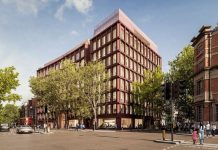UK offices saw more workers present on Wednesday 21st of April than at any other point since the start of the pandemic, data from the smart buildings software platform Metrikus has shown.
The second and third weeks of April saw office employees working in their offices in similar numbers to September 2020, with a peak of 44.72% of pre-pandemic levels of occupation on the 21st of April marking a new high in the Metrikus Occupancy Index.
Office occupancy fell to a weekly median of 16% in the last week of January 2021, before beginning a gradual recovery that saw a rise to a weekly median of 37% in the week commencing 12 April and 41% the following week – levels not seen since October 2020.
Michael Grant, Chief Operations Officer at Metrikus, commented:
“Metrikus’ data from last and the previous week indicate that occupancy levels in the UK’s offices are now back to where they were in September 2020 – but what lies ahead is uncharted territory – we’re watching closely to see whether the trend of growth of around 1.7 index points per week that we’ve seen since the end of February will continue to gradually accelerate.
“This peak comes a week ahead of our previous best guess, which was that offices would return to levels last seen in September 2020 by the beginning of May. Rather than spikes that track specific events, such as the return of children to school, the steady growth in the index seems to show that the gradual lifting of restrictions has slowly increased the appetite for some workers to return to the office.
“There’s a major opportunity to do more work to understand what impact the pandemic has had on working habits – looking at the days of the week, the most striking thing is how similar the patterns of occupancy are to pre-lockdown levels, albeit on a smaller scale: Tuesday and Wednesday regularly swap places as the busiest day of the week, and Fridays are without fail the least popular day of the week. As we look to occupy offices less densely than pre-pandemic, employers might look to incentivise staff to come in on Friday to reduce the pressure on more popular days of the week.
Metrikus has sensors and software installed on behalf of a variety of owners and occupiers in large office buildings in major cities around the UK. The data for this study was collected from two sources: people counting sensors in the entrance lobbies of office buildings that give a baseline for the number of people in the building, and motion sensors within offices that give an indication activity by showing which spaces are used, for how long, and at what times of day. The sensors are not able to discern between individuals, preventing the tracking of employees. Metrikus saw daily entries across the sample of buildings monitored for this study reach an aggregated peak of more than 41,000 in the months before the lockdown.
Metrikus customers have access to rich data visualisations that place a huge amount of built environment information on an easy to understand dashboard. The smart buildings platform uses secure software and sensors that building owners and occupiers can use to gain up-to-the minute information on everything from energy usage and air quality to fault prediction and detection on vital equipment. Metrikus is built on secure open standards that allow it to gather data from any sensor, meaning that if a quantity can be measured, it can be incorporated into a building’s personalised dashboard.

















